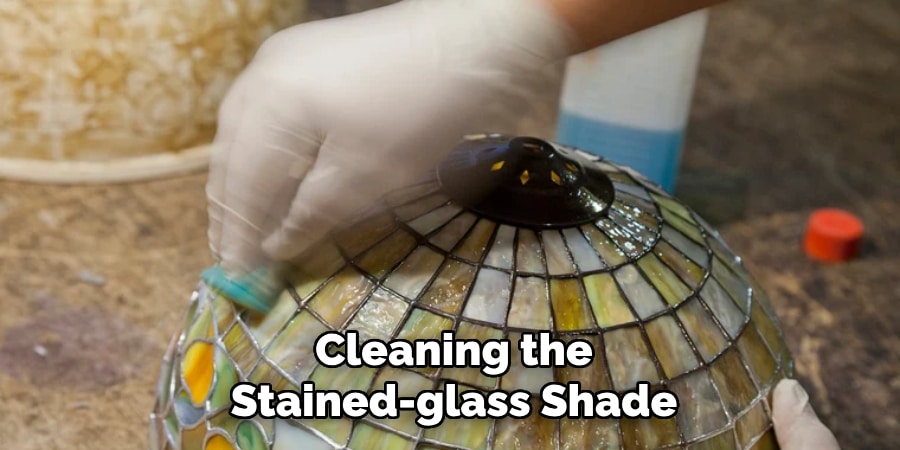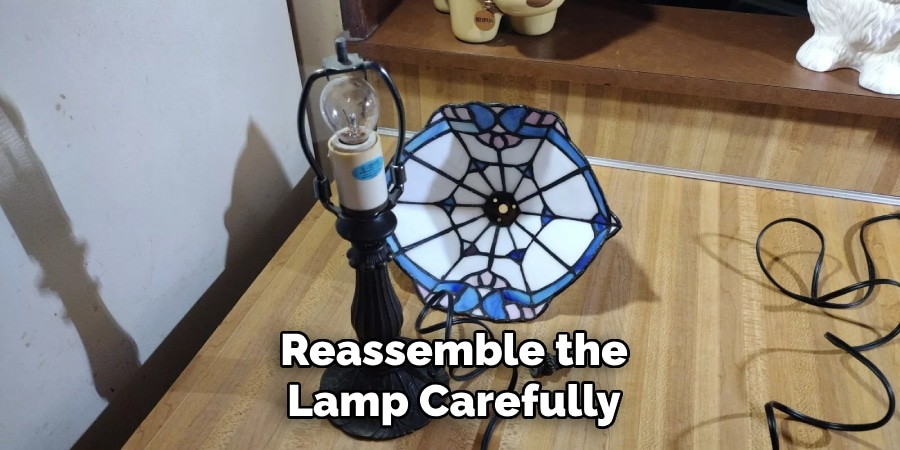Tiffany lamps are not just ordinary lighting fixtures; they are exquisite works of art that bring elegance and charm to any setting. Characterized by their vibrant stained-glass shades and ornate metalwork, these lamps require delicate care to maintain their stunning beauty. Over time, dust, grime, and oxidation can accumulate, diminishing their brilliance and intricate details.

However, improper cleaning methods can lead to severe damage, such as cracked glass, weakened soldering, or corroded metal components. Harsh chemicals and rough handling can compromise their structural integrity, reducing their lifespan. To ensure your Tiffany lamp remains in pristine condition, it is crucial to follow the right cleaning techniques.
This article provides a detailed guide on how to clean a tiffany lamp, from understanding its components to using appropriate tools and cleaning solutions. By following these steps, you can preserve your lamp’s timeless beauty and keep it a treasured part of your décor.
Tools and Materials Needed
To clean a Tiffany lamp effectively, you will need:
- Soft microfiber or lint-free cloths
- Mild soap or pH-neutral glass cleaner
- Soft-bristle brush or artist’s brush
- Cotton swabs
- Distilled water
- Compressed air
- Metal polish
Understanding the Structure of a Tiffany Lamp
Before cleaning a Tiffany lamp, it is essential to understand its structure and materials. These lamps are known for their elaborate stained-glass shades and unique construction.
Components of a Tiffany Lamp:
Stained-glass shade: Made using the lead or copper foil technique, individual glass pieces are joined together to form intricate designs. Metal framework: Often composed of bronze or brass, the framework provides support and detail to the lamp’s aesthetic. Lamp base: Made from materials such as glass, metal, or ceramic, each base complements the stained-glass shade in design and durability.

Differences Between Authentic and Reproduction Tiffany Lamps:
Authentic Tiffany lamps: Handmade, feature unique color variations, and are highly valuable. Reproductions: Mass-produced, often using different materials and less intricate craftsmanship.
Understanding these differences will help you apply the right cleaning methods without damaging the lamp’s delicate features.
Precautions Before Cleaning
Before you start cleaning, take the necessary precautions to avoid damaging your Tiffany lamp. Unplug the Lamp – Always disconnect the lamp from power to prevent electrical hazards. Check for Damage – Inspect for cracks, loose glass pieces, or weakened soldering. If damage is found, avoid deep cleaning until repairs are made.
Identify the Right Cleaning Method – The level of dirt and type of materials will determine how aggressive your cleaning approach should be. Test in a Small Area – Before cleaning the entire lamp, apply a mild cleaning solution on an inconspicuous part to check for any adverse reactions. Avoid Harsh Chemicals – Ammonia, vinegar, and other strong cleaners can damage the stained glass and metal framework.
6 Effective Steps How to Clean a Tiffany Lamp
Over time, dust and grime can accumulate, dulling their beauty. Follow these detailed steps to safely clean and maintain your lamp.
Step 1: Dusting the Lamp
Before applying any cleaning solution, begin by dusting the lamp to remove loose dirt and debris. Use a soft, dry microfiber cloth to gently wipe the surface of the lamp. For detailed areas and tight corners, a soft-bristle brush or compressed air can help remove dust without scratching the glass or metal framework.
Be careful not to apply too much pressure, as excessive force can loosen the soldering or shift glass pieces. Regular dusting prevents buildup, making deeper cleaning easier and less frequent.
Step 2: Cleaning the Stained-Glass Shade
The stained-glass shade is the most visually striking part of a Tiffany lamp, and maintaining its vibrancy requires careful cleaning. For light cleaning, dampen a microfiber cloth with distilled water mixed with mild soap. Gently wipe the glass, avoiding excessive moisture.

For deeper cleaning, use a pH-neutral glass cleaner applied to a cloth (never directly on the lamp) and wipe in circular motions. Be sure to avoid ammonia-based cleaners, as they can damage the stained glass and loosen the soldering.
For detailing in intricate areas, use cotton swabs to reach grooves and crevices, ensuring that every part of the design is free of dirt and grime. Avoid soaking the lamp or allowing moisture to seep into the framework, as trapped water can weaken the structure over time.
Step 3: Cleaning the Metal Parts
The metal framework of a Tiffany lamp is often made of brass, bronze, or other metals that can develop tarnish over time. To clean the metal components, first wipe them with a dry microfiber cloth to remove dust. If tarnish is present, apply a non-abrasive metal polish to a clean cloth and gently rub the affected areas.
Avoid using harsh chemical cleaners, as they can strip the lamp’s patina—a characteristic that gives antique lamps their vintage charm.
Buff lightly after applying the polish to restore shine without over-polishing. If the metal has intricate details, use a soft-bristle brush to clean hard-to-reach areas. Be cautious not to let any polish come into contact with the stained glass, as it can leave a residue that dulls its appearance.
Step 4: Cleaning the Base
The base of a Tiffany lamp varies in material, including glass, metal, or ceramic. If the base is made of glass, use the same cleaning method as for the stained-glass shade—wipe with a damp microfiber cloth and mild soap. For metal bases, a dry or slightly damp cloth should suffice, ensuring that no moisture comes into contact with electrical components.
If the base is ceramic, clean it with a gentle cloth and a mild soap solution, then dry it thoroughly to prevent water spots or discoloration. If the base has intricate carvings or recessed areas, use a soft-bristle brush or cotton swabs to reach difficult spots. Regular maintenance of the base prevents dust buildup and ensures the lamp remains stable and visually appealing.
Step 5: Inspecting for Loose or Damaged Parts
A crucial part of maintaining a Tiffany lamp is checking for any loose or damaged parts. Carefully examine the lamp for any cracks in the stained glass, weakened soldering, or shifting pieces. If you notice instability in the structure, avoid using the lamp until repairs are made. Minor repairs, such as securing a loose glass piece, can be done with a specialized stained-glass adhesive.

However, for more significant damage, such as a cracked shade or deteriorating framework, it is best to consult a professional to prevent further harm. Regular inspections help catch small issues before they become major problems, extending the lifespan of the lamp and preserving its artistic value.
Step 6: Cleaning the Light Bulb and Socket
The light bulb and socket often accumulate dust, which can affect the lamp’s brightness and functionality. Before cleaning, always turn off and unplug the lamp. Carefully remove the bulb and wipe it with a dry microfiber cloth to remove dust. If needed, use a slightly damp cloth, but ensure the bulb is completely dry before reinserting it into the socket.
Check the socket for dust buildup, as accumulated debris can impact electrical connections. Use compressed air or a soft-bristle brush to remove dust without damaging internal components. Regularly cleaning the bulb and socket ensures optimal performance and prolongs the lamp’s lifespan.
Step 7: Final Buffing and Reassembly
After all components are clean and dry, give the lamp a final gentle buff using a microfiber cloth. This helps remove any remaining streaks or residues, leaving the lamp with a polished, renewed appearance. If any parts were removed during the cleaning process, reassemble them carefully, ensuring that everything is securely in place.
Once reassembled, plug in the lamp and turn it on to admire its revitalized brilliance. A properly cleaned and maintained Tiffany lamp enhances any space, serving as a cherished decorative piece for years to come.
Maintaining Your Tiffany Lamp
Regular maintenance will keep your Tiffany lamp in pristine condition. Dust frequently using a soft, dry microfiber cloth to prevent buildup. Keep away from direct sunlight, as prolonged exposure can cause fading. Use gloves when handling to prevent fingerprints and oil stains on the glass.
Store in a dry, temperature-controlled area to prevent corrosion and moisture damage. Inspect electrical components periodically for safety and replace worn-out parts as needed.
Common Mistakes to Avoid
Using Ammonia-Based Cleaners: These can damage the stained glass over time. Scrubbing Too Hard: Excessive force can loosen solder or shift glass pieces. Applying Too Much Water: Excess moisture can seep into the framework and cause long-term damage. Ignoring Electrical Safety: Always unplug before cleaning to avoid potential hazards.

Frequently Asked Questions
Q: Can I use regular glass cleaner on my Tiffany lamp?
Ans: No, avoid ammonia-based glass cleaners as they can damage the stained glass and weaken the soldering. Instead, use a pH-neutral glass cleaner or mild soap with distilled water.
Q: How do I prevent my lamp’s metal framework from tarnishing?
Ans: Regular dusting and occasional polishing with a non-abrasive metal polish can help maintain the framework’s shine. Avoid excessive polishing to preserve the patina.
Q: Is it safe to use water when cleaning my Tiffany lamp?
Ans: Yes, but sparingly. Use a damp (not wet) microfiber cloth and avoid letting moisture seep into the framework or electrical components.
Q: Can I restore an old, heavily tarnished Tiffany lamp?
Ans: Yes, but restoration should be done carefully. Light cleaning can improve its appearance, but for extensive tarnish or damage, it’s best to seek professional restoration services.
Q: What’s the best way to remove stubborn dirt from the stained glass?
Ans: Use a microfiber cloth dampened with mild soap and water for gentle cleaning. For intricate areas, cotton swabs can help remove grime without causing damage.
Conclusion
A Tiffany lamp is a beautiful investment that requires careful handling and regular maintenance. By following the proper cleaning techniques outlined in this guide, you can keep your lamp shining brilliantly for years to come. Avoid common mistakes, use the right cleaning materials, and take preventive measures to preserve its delicate details.
Do you have any experiences or tips for cleaning Tiffany lamps? Share your thoughts in the comments below!
